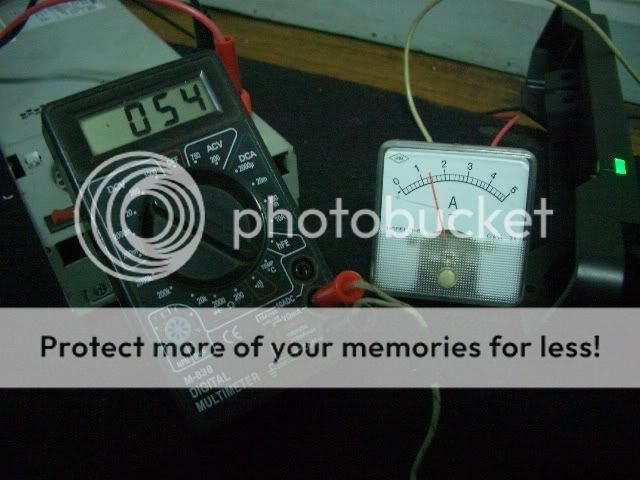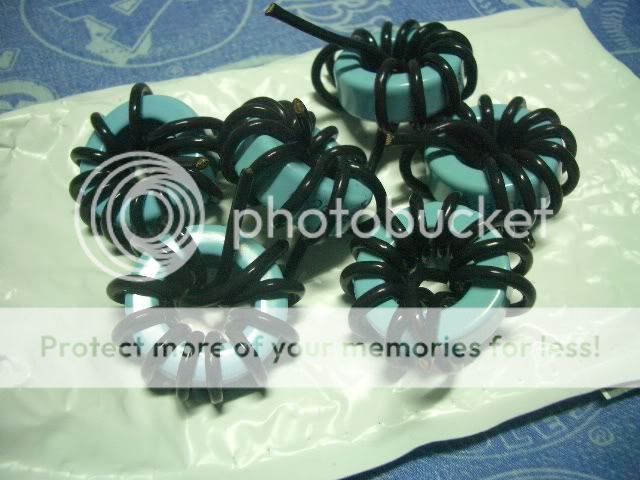I have installed the new inductors and after about 1hr15min run time on idle, inductor temp is 54degC with 24degC ambient temp. idle current is around 1.4A with 13.8V in.
here are some pics:



here are some pics:



I dunk them into a can of electrical varnish (used for transformers to improve HI-POT resistance). I usually soak them then dry then soak then dry several layers so that it coats the toroid thick.
look in electrical supplies and ask for varnish for soaking transformers. 😀
here's the amp. can't do high power testing since it's 11:30pm.
here's the amp. can't do high power testing since it's 11:30pm.

An externally hosted image should be here but it was not working when we last tested it.
Hi
Can you show me what you use for reference
The faster you go to sleep, faster you will be able to test it next day...but you probably won't be able go sleep now 😀
And let me say it looks great, whole setup 🙂
And they will be 😕 😕look in electrical supplies and ask for varnish for soaking transformers
Can you show me what you use for reference
The faster you go to sleep, faster you will be able to test it next day...but you probably won't be able go sleep now 😀
And let me say it looks great, whole setup 🙂
yes I might not be able to sleep now. 
I'm in the car right now with the laptop on wifi. can't leave my stereo alone. hehehe
BTW, thanks for those who guided me in fixing this amp. 😎

I'm in the car right now with the laptop on wifi. can't leave my stereo alone. hehehe
BTW, thanks for those who guided me in fixing this amp. 😎
I have done a bit of power testing with the amp.
with a 2 ohm load, with full signal I can send it into slight clipping (afraid to go further as the 8's are going into over excursion). clipping is clean as the tops of the sine wave simply flattens.
I have measured about 1055watts going into 2ohms and that already accounts for the voltage drop of the power cables. the only thing warm was the part of the top plate directly above the output inductor. the main heatsinks are only slightly warm.
with a 2 ohm load, with full signal I can send it into slight clipping (afraid to go further as the 8's are going into over excursion). clipping is clean as the tops of the sine wave simply flattens.
I have measured about 1055watts going into 2ohms and that already accounts for the voltage drop of the power cables. the only thing warm was the part of the top plate directly above the output inductor. the main heatsinks are only slightly warm.
I used an oscilloscope on the output terminals with the two 4ohm speakers in parallel. measured peak voltage and calculated rms volts then watts.
I made another vented box tuned a little higher. 1.4cuft 34Hz. my vision blurrs when inside the car. if you didn't know, you'd say I have two 12's at the back. 😀
I made another vented box tuned a little higher. 1.4cuft 34Hz. my vision blurrs when inside the car. if you didn't know, you'd say I have two 12's at the back. 😀
Does it only produce +/-65V peak with 2ohm load? I was expecting more (but it's just a car-audio amplifier). Use a music signal if you weren't doing so.
yes, I'm using a music signal. I wasn't able to measure the input voltage but I bet it was below 12V or so. my car has a small alternator.
Hi
Note that speakers change their impedance, you sure you really got that power?
You could use small "current" resistor to measure current and voltage after that to get more real power
Note that speakers change their impedance, you sure you really got that power?
You could use small "current" resistor to measure current and voltage after that to get more real power
I don't know. I wasn't trying to get the exact output. just a ballpark figure to know how much power there is. 😉
luka said:Hi
Note that speakers change their impedance, you sure you really got that power?
You could use small "current" resistor to measure current and voltage after that to get more real power
When calculating power, nominal impedance is usually taken because this allows to compare amplifiers. Then again, music signal is not a continuous tone and load impedance is strongly frequency dependent. Calculating the actual power involved requires a sophisticated analyzer and the reading would no longer be an indicator of how loud an amplifier can get.
had a trip this afternoon. around an hour with the amp blasting, and same thing when I returned home. amp is still alive. 😀
A/C was off, heatsink is around 45degC (didn't have my thermometer at hand) with minimal cooling.
the amp has more power than I'll ever need so I guess it will last with me. 😉
A/C was off, heatsink is around 45degC (didn't have my thermometer at hand) with minimal cooling.
the amp has more power than I'll ever need so I guess it will last with me. 😉
- Status
- Not open for further replies.
- Home
- General Interest
- Car Audio
- Kicker ZX1000.1 repair

 ...
...